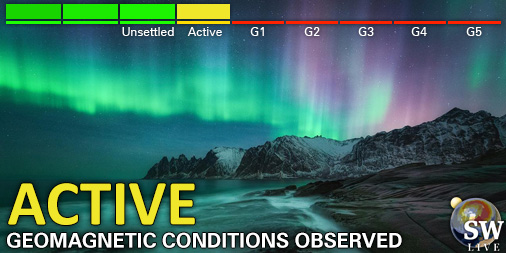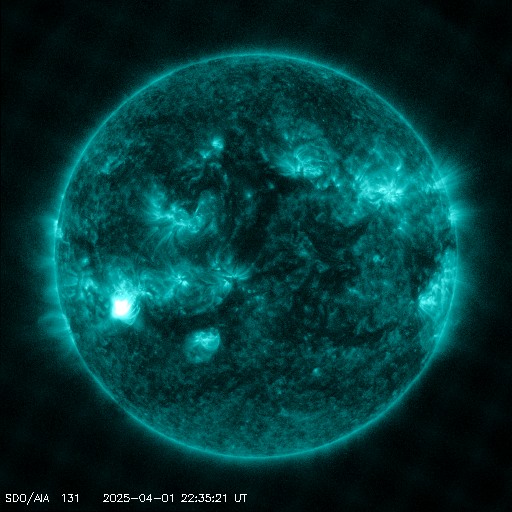Viewing archive of Wednesday, 3 August 2011
Solar activity report
Any mentioned solar flare in this report has a scaling factor applied by the Space Weather Prediction Center (SWPC). Because of the SWPC scaling factor, solar flares are reported as 42% smaller than for the science quality data. The scaling factor has been removed from our archived solar flare data to reflect the true physical units.
Report of Solar-Geophysical Activity 2011 Aug 03 2200 UTCPrepared by the NOAA © SWPC and processed by SpaceWeatherLive.com
Joint USAF/NOAA Report of Solar and Geophysical Activity
SDF Number 215 Issued at 2200Z on 03 Aug 2011IA. Analysis of Solar Active Regions and Activity from 02-2100Z to 03-2100Z
Solar activity was high. Region 1261 (N16W37) produced
the largest event of the period, an M6/2B flare at 03/1348Z. It was
accompanied by a 10cm radio burst (180 sfu), Type II (812 km/s) and
IV emissions. A CME was subsequently observed in STEREO-A COR2
imagery at 03/1409Z. Time-height extrapolation from LASCO C3
imagery indicated a speed of 624 km/s. Region 1263 (N17W06) also
produced an M1/1F flare at 03/0432Z. Both regions were classified
as Dki type spot groups with beta-gamma and beta-gamma-delta
magnetic characteristics respectively. A weak CME was also observed
in STEREO-A COR2 imagery at approximately 03/0109Z but was not
expected to be geoeffective.
IB. Solar Activity Forecast
Solar activity is likely to remain
moderate to high for the next three days (04-06 Aug) under the
continued threat of a major event. Regions 1261 and 1263 are most
likely to produce activity.
IIA. Geophysical Activity Summary 02-2100Z to 03-2100Z
The geomagnetic field was predominantly quiet. Wind speeds at the
ACE spacecraft were near 360 km/s and Bz was near zero. A slight
enhancement in 10 MeV protons was observed at both ACE and the
GOES-13 satellite, but remained below alert thresholds.
IIB. Geophysical Activity Forecast
The geomagnetic field is
expected to be mostly quiet on day 1 (04 Aug), becoming active on
days 2 and 3 (05-06 Aug), with a slight chance of minor to major
storms at high latitudes. The increased geomagnetic activity is
associated with the arrivals of CMEs from 02 and 03 August. The 10
MeV protons are likely to exceed the 10 pfu threshold with CME
passage.
III. Event Probabilities 04 Aug to 06 Aug
| Class M | 65% | 65% | 60% |
| Class X | 10% | 10% | 10% |
| Proton | 15% | 55% | 55% |
| PCAF | green | ||
IV. Penticton 10.7 cm Flux
Observed 03 Aug 120 Predicted 04 Aug-06 Aug 120/120/115 90 Day Mean 03 Aug 096
V. Geomagnetic A Indices
Observed Afr/Ap 02 Aug 003/003 Estimated Afr/Ap 03 Aug 003/003 Predicted Afr/Ap 04 Aug-06 Aug 005/005-020/025-018/020
VI. Geomagnetic Activity Probabilities 04 Aug to 06 Aug
| A. Middle Latitudes | |||
|---|---|---|---|
| Active | 05% | 40% | 25% |
| Minor storm | 01% | 10% | 05% |
| Major-severe storm | 01% | 05% | 01% |
| B. High Latitudes | |||
|---|---|---|---|
| Active | 05% | 40% | 40% |
| Minor storm | 01% | 15% | 15% |
| Major-severe storm | 01% | 05% | 05% |
All times in UTC
Current data suggests there is a slight possibility for aurora to appear at the following high latitude regions in the near future
Fairbanks, AKLatest news
Latest forum messages
AR4048 101Temporary Topic - Ongoing Solar Proton Events 17jsoc 108Unexplained proton activity 52Unspecified geomagnetic activity 2188
More topicsSupport SpaceWeatherLive.com!
A lot of people come to SpaceWeatherLive to follow the Sun's activity or if there is aurora to be seen, but with more traffic comes higher server costs. Consider a donation if you enjoy SpaceWeatherLive so we can keep the website online!

Latest alerts
Wednesday, 2 April 2025
04:03 UTC - Hemispheric Power Index
The OVATION model predicts the Hemispheric Power Index to reach 50GW at 04:56 UTC
01:45 UTC - Geomagnetic activity
Active geomagnetic conditions (Kp4) Threshold Reached: 01:32 UTC
Tuesday, 1 April 2025
22:51 UTC - Solar flare
Moderate M2.5 flare
22:30 UTC - Radio Blackout
Minor R1 radio blackout in progress (≥M1 - current: M1.45)
Space weather facts
| Last X-flare | 2025/03/28 | X1.1 |
| Last M-flare | 2025/04/01 | M2.5 |
| Last geomagnetic storm | 2025/03/27 | Kp5 (G1) |
| Spotless days | |
|---|---|
| Last spotless day | 2022/06/08 |
| Monthly mean Sunspot Number | |
|---|---|
| February 2025 | 154.6 +17.6 |
| April 2025 | 152.5 -2.1 |
| Last 30 days | 130.7 -17.9 |




